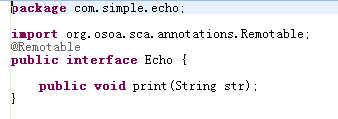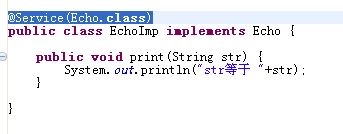Tuscany简单应用
简单的例子:
配置文件:
<?
xml version="1.0" encoding="UTF-8"
?>
<
composite
xmlns
="http://www.osoa.org/xmlns/sca/1.0"
xmlns:t
="http://tuscany.apache.org/xmlns/sca/1.0"
xmlns:c
="http://sample"
targetNamespace
="http://sample"
name
="sample"
>
<!--
对外接口 访问地址:http://localhost:8080/echoComponent?wsdl
-->
<
service
name
="echo"
promote
="echoComponent"
>
<
interface.java
interface
="com.simple.echo.Echo"
></
interface.java
>
<
binding.ws
uri
="http://localhost:8080/echoComponent"
></
binding.ws
>
</
service
>
<!--
组件声明
-->
<
component
name
="echoComponent"
>
<
implementation.java
class
="com.simple.echo.EchoImp"
></
implementation.java
>
</
component
>
</
composite
>
代码:
@Test
public
void
测试组件调用() {
//
TODO 获取组件,并设用
SCADomain domain
=
SCADomain.newInstance(
"
com/config/simple/echo.composite
"
);
Echo echo
=
domain.getService(Echo.
class
,
"
echoComponent
"
);
echo.print(
"
我是神人
"
);
}
public
class
EchoImp
implements
Echo {
public
void
print(String str) {
System.out.println(
"
str等于
"
+
str)
服务:
简单例子后,我们知道了,我们可以直接调用使用component的实现,而服务是启动域时或启动节点发布的;
此时我们进行服务的编写:
服务 - 屏蔽一些不常用的功能;
<service>…</service>
主要: interface ,binding,callback
1.interface :
<interface.java interface="com.simple.echo.Echo"></interface.java>
对应的接口:
@Remotable
public interface Echo {
public void print(String str);
}
注意:服务中引用interface,必须要声明远程调用(@Remotable)
2.binging 绑定:
一.正常使用:
<
component
name
="echoComponent"
>
<
implementation.java
class
="com.simple.echo.EchoImp"
/>
<
service
name
="Echo"
>
// 此处是接口名,当使用组件内部时,一定要这样做
<
binding.ws
uri
="http://localhost:8080/echoComponent"
></
binding.ws
>
</
service
>
</
component
>
代码方面:
1.接口要使用 : @Remotable

2.实现要使用 : @Service(Echo.class)

实现提供的多个服务:
@Service(interfaces
=
{HelloService.
class
, AnotherInterface.
class
})
public
class
HelloServiceImpl
implements
HelloService, AnotherInterface{..}
3. reference 引用:
适用于一个组件引用其他组件处理;
XML : reference标签:
属性: 1.name (必须) – 变量名,必须与类的变量名相同
说明: <reference name="reture" target="EchoReture">
private EchoReture reture = null; // 两处名称必须相同;
2.promote (compusite层时必须) –指定相关的组件实现;
3.target(可选) – 被引用的组件名字 - 组件名/服务名,声明此属性,则是在同compusite调用;
子标签: 1.binding(选定) - 绑定调用的接口或服务,用于调用不再一个域内的服务;
2.interface(选定) - 引用接口,暂时只在回调时用到,其他用处不详
@Reference : 属性: name(可选的) — 注入变量名,默认为Java类的数据成员名;
required(可选的) — 是否必须注入服务。默认为true;
个人理解:相较与spring的IOC很相似;
如:<bean><属性 名字="" ref=""/></bean>
原理:本component内部声明一个引用,必然是引用另一个组件;
相关代码:
<
component
name
="echoComponent"
>
<
implementation.java
class
="com.simple.echo.EchoImp"
/>
<
service
name
="Echo"
>
<
binding.ws
uri
="http://localhost:8080/echoComponent"
></
binding.ws
>
</
service
>
<
reference
name
="reture"
target
="EchoReture"
>
</
reference
>
</
component
>
<
component
name
="EchoReture"
>
<
implementation.java
class
="com.simple.Client.EchoRetureImp"
/>
</
component
>
java代码:
@Service(Echo.
class
)
public
class
EchoImp
implements
Echo {
private
EchoReture reture
=
null
;
@Reference(name
=
"
reture
"
)
//
重点:设置注入方法;
public
void
setReture(EchoReture reture) {
this
.reture
=
reture;
}
public
void
print(String str) {
System.out.println(
"
str等于
"
+
str);
}
public
void
printString() {
reture.getEcho();
}
}
其他无用类省略…;
4.property 属性
一个属性可以是简单数据类型或XML可以通过代码实现或者注解;
name(必须)– 定义名字;
many (可选) – 是否多个值, 默认false;
mustSupply (可选) –是否必填,默认false;
source(可选) –引用其他属性 - 使用$XXX
简单例子: 注入字符串:
XML:
<
component
name
="loginCompunent_string"
>
<
implementation.java
class
="com.simple.property.LogionAction_String"
/>
<
property
name
="username"
>
wang
</
property
>
<
property
name
="password"
>
123456
</
property
>
</
component
>
代码:
public
class
LogionAction_String {
private
String username
=
null
;
private
String password
=
null
;
@Property(name
=
"
username
"
)
//
注入XML配置的值
public
void
setUsername(String username) {
this
.username
=
username;
}
@Property(name
=
"
password
"
)
//
注入XML配置的值
public
void
setPassword(String password) {
this
.password
=
password;
}
public
User login()
throws
Exception {
//
TODO 判断输入是否正确,并返回用户对象
//
1.验证传递用户是否符合输入规范;
//
2.记录登录人信息;
//
3.创建用户对象,并赋值;
//
4.返回对象;
/*
1.0 判断用户是否为null
*/
if
(username
!=
null
&&
password
!=
null
) {
/*
2.0 登录信息记录
*/
System.out.println(
"
用户 :
"
+
username
+
"
密码 :
"
+
password
+
"
成功登录
"
);
/*
3.0 创建用户,赋值
*/
User user
=
new
User();
user.setUsername(username);
user.setPassword(password);
return
user;
/*
4.0 返回对象
*/
}
else
throw
new
NullPointerException(
"
username或password - 不存在
"
);
}
}